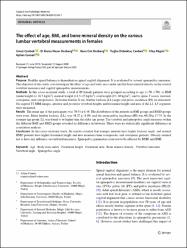The effect of age, BMI, and bone mineral density on the various lumbar vertebral measurements in females

Göster/
Tarih
2020Yazar
Canbek, UmutHazer Rosberg, Derya Burcu
Rosberg, Hans Eric
Canbek, Tuğba Dübektaş
Akgün, Ulaş
Cömert, Ayhan
Üst veri
Tüm öğe kaydını gösterÖzet
Purpose Healthy spinal balance is dependent on spinal sagittal alignment. It is evaluated by several spinopelvic measures. The objective of this study is to investigate the effect of age and body mass index and the bone mineral density on the several vertebral measures and sagittal spinopelvic measurements. Methods In this cross-sectional study, a total of 89 female patients were grouped according to age (> 70, < 70); to BMI (underweight (< 18.5 kg/m(2)), normal weight (18.5-25 kg/m(2)), overweight (25-30 kg/m(2)); and to spineTscores (normal, osteopenia, and osteoporosis). On lateral lumbar X-ray, lumbar lordosis (LL) angle and pelvic incidence (PI) are measured. On sagittal T2 MRI images, anterior and posterior vertebral heights and foraminal height and area of the L1-L5 segments were measured. Results The mean age of the participants was 70.54 +/- 6.49. The distribution of the patients in BMI groups and BMD groups were even. Mean lumber lordosis (LL) was 48.27 +/- 18.06, and the mean pelvic incidence (PI) was 60.20 +/- 15.74. In the younger age group, LL was found to be higher than the older age group. The vertebral and spinopelvic angle measures within the different BMI and BMD groups revealed no difference in between. There were no statistically significant difference in correlation analysis. Conclusion In this cross-sectional study, the results revealed that younger patients have higher lordosis angle, and normal BMD patients have higher foraminal height and area measures than osteoporotic and osteopenic patients. Obesity seemed not to have any influence on vertebral measures. Spinopelvic parameters seem not to be effected by BMD and BMI.

















